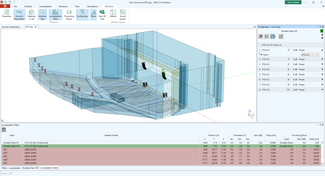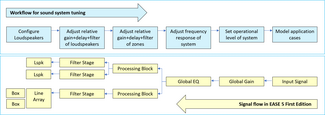EASE 5-FE – Mapping the complete signal processing chain for easy sound system modeling

It is a common workflow for sound system designers to first configure the individual settings of loudspeakers and line arrays, and then tune them relative to each other, zone by zone. After that, different zones or loudspeaker groups need to be adjusted with respect to gain and relative delays. Finally, for the complete sound system, the frequency response is corrected as well as the operational level of the system is set. The input signal is defined by the application scenario or program material.
In EASE 5-FE, all of these stages are mapped in well-ordered windows and views that can be accessed and configured easily.
Single elements of the sound system: Within the loudspeaker or line array properties window and the filters window, each single loudspeaker or line array can be defined and configured using the EASE 5-FE filter bank, including gain, delay, polarity and all common types of filters: peak, high-pass, low-pass, all pass, high-shelf, and low-shelf.

For line arrays, input configurations as well as filter presets and individual box gains can be adjusted within the line array configurator or they can be imported via XGLC configuration files. This way even advanced filter settings and FIR filters generated by loudspeaker manufacturer’s software can be used for EASE simulations.
Loudspeaker groups and zones: In EASE 5-FE these groups are defined in processing blocks, that represent the typical capabilities of DSP units or amplifiers. The blocks allow setting relative gains or specific delays for system zones and audience areas. Parametric filters or group EQ can also be applied for groups of loudspeakers.
Global system settings: In the acoustic parameters window of EASE 5-FE, the operational level of the sound system can be set using the global gain. The sound system can be tuned using all standard filters to equalize frequencies and adjust the frequency response of the system as needed.
Depending on the planned use of the room, the input signal can also be selected. In EASE 5-FE, one can choose from the Pink Noise, Speech, Program, and Music settings representing the spectral characteristics of the anticipated acoustic content.
Data export: For documentation and transfer of single loudspeaker and processing block settings, the loudspeaker table can be exported.

To sum up, at any stage of the realization of your project, EASE 5-FE enables you to monitor and control all signal processing parameters like common practice. This simplifies the workflow of tuning the sound system tremendously.
Read more about the new tools and workflows of EASE 5-FE ! >>
Important Note
EASE 4 users upgrading to EASE 5 will retain their existing EASE 4 license. In this manner, the transition to the new platform can happen smoothly and will take into account already running projects.